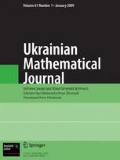A subgroup H of a finite group G is said to be Hall S-quasinormally embedded in G if H is a Hall subgroup of the S-quasinormal closure H SQG . We study finite groups G containing a Hall S-quasinormally embedded subgroup of index p n for each prime power divisor p n of the order of G.
Similar content being viewed by others
References
A. Ballester-Bolinches, J. C. Beidleman, and R. Esteban-Romero, “On some classes of supersoluble groups,” J. Algebra, 312, 445–454 (2007).
A. Ballester-Bolinches, R. Esteban-Romero, and M. Asaad, Products of Finite Groups,Walter de Gruyter, Berlin; New York (2010).
F. Barry, “The commutator subgroup and CLT(NCLT) groups,” Math. Proc. R. Ir. Acad. A, 104, 119–126 (2004).
F. Barry, D. MacHale, and Á. Ní Shé, “Some supersolvability conditions for finite groups,” Math. Proc. R. Ir. Acad. A, 106, 163–177 (2006).
S. Baskaran, “On product of two CLT normal subgroups,” Math. Nachr., 83, 89–91 (1978).
T. R. Berger, “A converse to Lagrange’s theorem,” J. Austral. Math. Soc., 25, 291–313 (1978).
R. Brandl, “CLT groups and wreath products,” J. Austral. Math. Soc. Ser. A, 42, 183–195 (1987).
R. Brandl and P. A. Linnell, “Character degrees and CLT-groups,” Bull. Austral. Math. Soc., 39, 249–254 (1989).
H. G. Bray, “A note on CLT groups,” Pacif. J. Math., 27, 229–231 (1968).
M. Brennan, “A note on the converse to Lagrange’s theorem,” Math. Gazette, 82, 286–288 (1998).
M. J. Curran, “Non-CLT groups of small order,” Comm. Algebra, 11, 111–126 (1983).
K. Doerk and T. Hawkes, Finite Soluble Groups, Walter de Gruyter, Berlin; New York (1992).
T. M. Gagen, “A note on groups with the inverse Lagrange property,” Group Theory (Proc. Miniconf., Austral. Nat. Univ., Canberra, 1975): Lect. Notes Math., Springer, Berlin, 573, 51–52 (1977).
H. Heineken, “Groups with all quotient groups Lagrangian,” Arch. Math., 64, 97–102 (1995).
C. V. Holmes, “A characterization of finite nilpotent groups,” Amer. Math. Monthly, 73, 1113–1114 (1966).
J. F. Humphreys, “On groups satisfying the converse of Lagrange’s theorem,” Proc. Cambridge Phil. Soc., 75, 25–32 (1974).
J. F. Humphreys and D. L. Johnson, “On Lagrangian groups,” Trans. Amer. Math. Soc., 180, 291–300 (1973).
B. Huppert, Endliche Gruppen I, Springer-Verlag, Berlin, etc. (1967).
N. Jing, “The order of groups satisfying a converse to Lagrange’s theorem,” Mathematika, 47, 197–204 (2000).
S. R. Li, J. He, G. P. Nong, and L. Q. Zhou, “On Hall normally embedded subgroups of finite groups,” Comm. Algebra, 37, No. 9, 3360–3367 (2009).
J. J. Liu, S. R. Li, and J. He, “CLT-groups with normal or abnormal subgroups,” J. Algebra, 362, 99–106 (2012).
D. McCarthy, “Sylow’s theorem is a sharp partial converse to Lagrange’s theorem,” Math. Z., 113, 383–384 (1970).
D. H. McLain, “The existence of subgroups of given order in finite groups,” Proc. Cambridge Phil. Soc., 53, 278–285 (1957).
O. Ore, “Contributions to the theory of groups of finite order,” Duke Math. J., 5, 431–460 (1939).
D. J. S. Robinson, A Course in the Theory of Groups, Springer, New York (1982).
J. N. Salunke and A. R. Gotmare, “Converse of Lagrange’s theorem and solvable groups,” Bull. Marathwada Math. Soc., 10, 36–42 (2009).
R. R. Struik, “Partial converses to Lagrange’s theorem,” Comm. Algebra, 6, 421–482 (1978).
R. R. Struik, “Partial converses to Lagrange’s theorem II,” Comm. Algebra, 9, 1–22 (1981).
Between Nilpotent and Solvable, M. Weinstein (ed.), Polygonal Publ. House, Passaic, Jersey (1982).
G. Zappa, “Remark on a recent paper of O. Ore,” Duke Math. J., 6, 511–512 (1940).
L. W. Zhang, “The supersolvability of QCLT groups,” Acta Math. Sinica (N. S.), 1, 378–381 (1985).
Author information
Authors and Affiliations
Additional information
Published in Ukrains’kyi Matematychnyi Zhurnal, Vol. 66, No. 8, pp. 1146–1152, August,
Rights and permissions
About this article
Cite this article
Liu, J., Li, S. CLT-Groups with Hall S-Quasinormally Embedded Subgroups. Ukr Math J 66, 1281–1288 (2015). https://doi.org/10.1007/s11253-015-1008-1
Received:
Revised:
Published:
Issue Date:
DOI: https://doi.org/10.1007/s11253-015-1008-1


